Interactive Effects of Subsidiary Crops and Weed Pressure in the Transition Period to Non-Inversion Tillage, A Case Study of Six Sites Across Northern and Central Europe
Abstract
:1. Introduction
2. Materials and Methods
2.1. Experimental Design
2.2. Data Collection
2.3. Statistic Analysis
3. Results
3.1. Weed Abundance and Species Composition
3.2. Effect of Subsidiary Crops on the Weed Abundance
3.2.1. Weed Control
3.2.2. Differences between Subsidiary Crop Sowing Time (SCu and SCp) and Species
3.3. Effect of N Fertilization on the Weed Abundance
3.4. Effect of Tillage on the Weed Abundance
3.5. Effect of the Interaction between Subsidiary Crops and Tillage on the Weed Abundance
3.5.1. Non-Inversion Tillage and Subsidiary Crops vs. Ploughing System
3.5.2. Combination of Tillage and Subsidiary Crop with Highest Weed Control
4. Discussion
5. Conclusions
Supplementary Materials
Author Contributions
Funding
Acknowledgments
Conflicts of Interest
References
- Krauss, M.; Berner, A.; Burger, D.; Wiemken, A.; Niggli, U.; Mäder, P. Reduced tillage in temperate organic farming: Implications for crop management and forage production. Soil Use Manag. 2010, 26, 12–20. [Google Scholar] [CrossRef]
- Scopel, E.; Triomphe, B.; Affholder, F.; Da Silva, F.A.M.E.; Corbeels, M.; Xavier, J.H.V.; Lahmar, R.; Recous, S.; Bernoux, M.; Blanchart, E.; et al. Conservation agriculture cropping systems in temperate and tropical conditions, performances and impacts. A review. Agron. Sustain. Dev. 2013, 33, 113–130. [Google Scholar] [CrossRef]
- Chan, K.Y. An overview of some tillage impacts on earthworm population abundance and diversity—Implications for functioning in soils. Soil Tillage Res. 2000, 57, 179–191. [Google Scholar] [CrossRef]
- Pelosi, C.; Pey, B.; Hedde, M.; Caro, G.; Capowiez, Y.; Guernion, M.; Peigné, J.; Piron, D.; Bertrand, M.; Cluzeau, D. Reducing tillage in cultivated fields increases earthworm functional diversity. Appl. Soil Ecol. 2014, 83, 79–87. [Google Scholar] [CrossRef]
- Holland, J.M. The environmental consequences of adopting conservation tillage in Europe: Reviewing the evidence. Agric. Ecosyst. Environ. 2004, 103, 1–25. [Google Scholar] [CrossRef]
- Govaerts, B.; Verhulst, N.; Castellanos-Navarrete, A.; Sayre, K.D.; Dixon, J.; Dendooven, L. Conservation agriculture and soil carbon sequestration: Between myth and farmer reality. Crit. Rev. Plant Sci. 2009, 28, 97–122. [Google Scholar] [CrossRef]
- Haddaway, N.R.; Hedlund, K.; Jackson, L.E.; Kätterer, T.; Lugato, E.; Thomsen, I.K.; Jørgensen, H.B.; Isberg, P.E. How does Tillage Intensity Affect Soil Organic Carbon? A Systematic Review; BioMed Central: London, UK, 2017. [Google Scholar]
- Seitz, S.; Goebes, P.; Puerta, V.L.; Pereira, E.I.P.; Wittwer, R.; Six, J.; van der Heijden, M.G.A.; Scholten, T. Conservation tillage and organic farming reduce soil erosion. Agron. Sustain. Dev. 2019, 39, 4. [Google Scholar] [CrossRef]
- Montgomery, D.R. Soil erosion and agricultural sustainability. Proc. Natl. Acad. Sci. USA 2007, 104, 13268–13272. [Google Scholar] [CrossRef] [Green Version]
- Baral, K.R. Review: Weed management in organic farming through conservation agriculture practive. J. Agric. Environ. 2012, 13, 60–66. [Google Scholar] [CrossRef]
- Peigné, J.; Ball, B.C.; Roger-Estrade, J.; David, C. Is conservation tillage suitable for organic farming? A review. Soil Use Manag. 2007, 23, 129–144. [Google Scholar] [CrossRef]
- Vakali, C.; Zaller, J.G.; Köpke, U. Reduced tillage effects on soil properties and growth of cereals and associated weeds under organic farming. Soil Tillage Res. 2011, 111, 133–141. [Google Scholar] [CrossRef]
- Hǻkansson, S. Weeds and Weed Management on Arable Land: An Ecological Approach; Hakansson, S., Ed.; CABI: Wallingford, UK, 2003. [Google Scholar]
- Semb Tørresen, K.; Skuterud, R.; Trandsæther, H.J.; Bredesen Hagemo, M. Long-term experiments with reduced tillage in spring cereals. I. Effects on weed flora, weed seedbank and grain yield. Crop Prot. 2003, 22, 185–200. [Google Scholar] [CrossRef]
- Peigné, J.; Casagrande, M.; Payet, V.; David, C.; Sans, F.X.; Blanco-Moreno, J.M.; Cooper, J.; Gascoyne, K.; Antichi, D.; Bàrberi, P.; et al. How organic farmers practice conservation agriculture in Europe. Renew. Agric. Food Syst. 2016, 31, 72–85. [Google Scholar] [CrossRef]
- Sans, F.X.; Berner, A.; Armengot, L.; Mäder, P. Tillage effects on weed communities in an organic winter wheat-sunflower-spelt cropping sequence. Weed Res. 2011, 51, 413–421. [Google Scholar] [CrossRef]
- Barberi, P.; Aendekerk, R.; Antichi, D.; Armengot, L.; Berner, A.; Bigongiali, F.; Blanco-Moreno, J.M.; Carlesi, S.; Celette, F.; Chamorro, L.; et al. Reduced tillage and cover crops in organic arable systems preserve weed diversity without jeopardising crop yield. Build. Org. Bridges 2014, 3, 765–767. [Google Scholar]
- Büchi, L.; Wendling, M.; Amossé, C.; Necpalova, M.; Charles, R. Importance of cover crops in alleviating negative effects of reduced soil tillage and promoting soil fertility in a winter wheat cropping system. Agric. Ecosyst. Environ. 2018, 256, 92–104. [Google Scholar] [CrossRef]
- Swanton, C.J.; Weise, S.F. Integrated Weed Management: The Rationale and Approach. Weed Technol. 1991, 5, 657–663. [Google Scholar] [CrossRef]
- Bàrberi, P.; Mazzoncini, M. Changes in weed community composition as influenced by cover crop and management system in continuous corn. Weed Sci. 2001, 49, 491–499. [Google Scholar] [CrossRef]
- Carlesi, S.; Antichi, D.; Bigongiali, F.; Mazzoncini, M.; Barberi, P. Long term effects of cover crops on weeds in Mediterranean low input arable management systems. In Proceedings of the 17th European Weed Research Society Symposium, Montpellier, France, 22–26 June 2015. [Google Scholar]
- Hartwig, N.L.; Ammon, H.U. Cover crops and living mulches. Weed Sci. 2002, 50, 688–699. [Google Scholar] [CrossRef]
- Thorup-Kristensen, K.; Magid, J.; Jensen, L.S. Catch crops and green manures as biological tools in nitrogen management in temperate zones. Adv. Agron. Vol. 2003, 79, 227–302. [Google Scholar]
- Bàrberi, P. Weed management in organic agriculture: Are we addressing the right issues? Weed Res. 2002, 42, 177–193. [Google Scholar] [CrossRef]
- Liebman, M.; Davis, A.S. Integration of soil, crop and weed management in low-external-input farming systems. Weed Res. 2000, 40, 27–47. [Google Scholar] [CrossRef] [Green Version]
- Teasdale, J.R.; Brandsaeter, L.O.; Calegari, A.; Skora Neto, F. Cover crops and weed management. In Non- Chemical Weed Management; Upadhyaya, M.K., Blackshaw, R.E., Eds.; CAB International: Vancouver, BC, Canada, 2007; pp. 49–64. [Google Scholar]
- Blackshaw, R.E.; Moyer, J.R.; Doram, R.C.; Boswell, A.L. Yellow sweetclover, green manure, and its residues effectively suppress weeds during fallow. Weed Sci. 2001, 49, 406–413. [Google Scholar] [CrossRef]
- Gfeller, A.; Herrera, J.M.; Tschuy, F.; Wirth, J. Explanations for Amaranthus retroflexus growth suppression by cover crops. Crop Prot. 2018, 104, 11–20. [Google Scholar] [CrossRef]
- Teasdale, J.R.; Mohler, C.L. Light Transmittance, soil temperature, and soil moisture under residue of hairy vetch and rye. Agron. J. 1993, 85, 673. [Google Scholar] [CrossRef]
- Gallandt, E.R.; Molloy, T.; Lynch, R.P.; Drummond, F.A. Effect of cover-cropping systems on invertebrate seed predation. Weed Sci. 2005, 53, 69–76. [Google Scholar] [CrossRef]
- Thorsted, M.D.; Weiner, J.; Olesen, J.E. Above- and below-ground competition between intercropped winter wheat Triticum aestivum and white clover Trifolium repens. J. Appl. Ecol. 2006, 43, 237–245. [Google Scholar] [CrossRef]
- Schipanski, M.E.; Barbercheck, M.; Douglas, M.R.; Finney, D.M.; Haider, K.; Kaye, J.P.; Kemanian, A.R.; Mortensen, D.A.; Ryan, M.R.; Tooker, J.; et al. A framework for evaluating ecosystem services provided by cover crops in agroecosystems. Agric. Syst. 2014, 125, 12–22. [Google Scholar] [CrossRef]
- Dabney, S.M.; Delgado, J.A.; Reeves, D.W. Using winter cover crops to improve soil and water quality. Commun. Soil Sci. Plant Anal. 2001, 32, 1221–1250. [Google Scholar] [CrossRef]
- Langdale, G.W.; Blevis, R.L.; Karlen, D.L.; McCool, D.K.; Nearing, M.A.; Skidmore, E.L.; Thomas, A.W.; Tyler, D.D.; Williams, J.R. Cover crop effects on soil erosion by wind and water. In Cover Crops Clean Water; Soil and Water Conservation Society: Ankeny, IA, USA, 1991; pp. 15–22. [Google Scholar]
- Ladoni, M.; Basir, A.; Robertson, P.G.; Kravchenko, A.N. Scaling-up: Cover crops differentially influence soil carbon in agricultural fields with diverse topography. Agric. Ecosyst. Environ. 2016, 225, 93–103. [Google Scholar] [CrossRef]
- Blackshaw, R.E.; Brandt, R.N.; Janzen, H.H.; Entz, T.; Grant, C.A.; Derksen, D.A. Differential response of weed species to added nitrogen. Weed Sci. 2003, 51, 532–539. [Google Scholar] [CrossRef]
- Dhima, K.V.; Eleftherohorinos, I.G. Influence of nitrogen on competition between winter cereals and sterile oat. Weed Sci. 2001, 49, 77–82. [Google Scholar] [CrossRef]
- Ampong-Nyarko, K.; Datta, S.K. Effects of nitrogen application on growth, nitrogen use efficiency and rice-weed interaction. Weed Res. 1993, 33, 269–276. [Google Scholar] [CrossRef]
- Carlson, H.L.; Hill, J.E. Wild oat (Avena fatua) competition with spring wheat: Effects of nitrogen fertilization. Weed 1985, 34, 29–33. [Google Scholar] [CrossRef]
- Santos, B.M.; Morales-Payan, J.P.; Stall, W.M.; Thomas, A. Influence of purple nutsedge (Cyperus rotundus) density and nitrogen rate on radish (Raphanus sativus) Yield. Weed Sci. 1998, 46, 661–664. [Google Scholar] [CrossRef]
- Krikham, F.W.; Kent, M. Soil seed bank composition in relation to the above-ground vegetation in fertilized and unfertilized hay meadows on a Somerset peat moor. J. Appl. Ecol. 1997, 34, 889–902. [Google Scholar] [CrossRef]
- Agenbag, G.A.; de Villiers, O.T. The effect of nitrogen fertilizers on the germination and seedling emergence of wild oat (A. fatua L.) seed in different soil types. Weed Res. 1989, 29, 239–245. [Google Scholar] [CrossRef]
- Hirel, B.; Le Gouis, J.; Ney, B.; Gallais, A. The challenge of improving nitrogen use efficiency in crop plants: Towards a more central role for genetic variability and quantitative genetics within integrated approaches. J. Exp. Bot. 2007, 58, 2369–2387. [Google Scholar] [CrossRef] [PubMed]
- Błażewicz-Woźniak, M.; Patkowska, E.; Konopiński, M.; Wach, D. The effect of cover crops and ploughless tillage on weed infestation of field after winter before pre-sowing tillage. Romanian Agric. Res. 2016, 33, 185. [Google Scholar]
- Jongman, R.H.G.; Bunce, R.G.H.; Metzger, M.J.; Mücher, C.A.; Howard, D.C.; Mateus, V.L. Objectives and applications of a statistical environmental stratification of Europe. Landsc. Ecol. 2006, 21, 409–419. [Google Scholar] [CrossRef]
- Viechtbauer, W. Conducting meta-analyses in R with the metafor package. J. Stat. Softw. 2010, 36, 1–48. [Google Scholar] [CrossRef]
- Sawilowsky, S.S. New effect size rules of thumb. J. Mod. Appl. Stat. Methods 2009, 8, 597–599. [Google Scholar] [CrossRef]
- Higgins, J.P.T.; Thompson, S.G. Quantifying heterogeneity in a meta-analysis. Stat. Med. 2002, 21, 1539–1558. [Google Scholar] [CrossRef] [PubMed]
- Hyvönen, T.; Ketoja, E.; Salonen, J.; Jalli, H.; Tiainen, J. Weed species diversity and community composition in organic and conventional cropping of spring cereals. Agric. Ecosyst. Environ. 2003, 97, 131–149. [Google Scholar] [CrossRef]
- Lososová, Z.; Chytrý, M.; Cimalová, Š.; Kropáč, Z.; Otýpková, Z.; Pyšek, P.; Tichý, L. Weed vegetation of arable land in Central Europe: Gradients of diversity and species composition. J. Veg. Sci. 2004, 15, 415–422. [Google Scholar] [CrossRef]
- Salonen, J.; Hyvonen, T.; Jalli, H. Weeds in spring cereal fields in Finland—A third survey. Agric. Food Sci. 2001, 10, 347–364. [Google Scholar] [CrossRef]
- Tuesca, D.; Puricelli, E.; Papa, J.C. A long-term study of weed flora shifts in different tillage systems. Weed Res. 2001, 14, 369–382. [Google Scholar] [CrossRef]
- Moonen, A.; Barberi, P. Size and composition of the weed seedbank after 7 years of different cover crop maize management systems. Weed Res. 2004, 44, 163–177. [Google Scholar] [CrossRef]
- Baraibar, B.; Hunter, M.C.; Schipanski, M.E.; Hamilton, A.; Mortensen, D.A. Weed suppression in cover crop monocultures and mixtures. Weed Sci. 2018, 66, 121–133. [Google Scholar] [CrossRef]
- Schmidt, J.H.; Junge, S.; Finckh, M.R. Cover crops and compost prevent weed seed bank buildup in herbicide-free wheat–potato rotations under conservation tillage. Ecol. Evol. 2019, 9, 2715–2724. [Google Scholar] [CrossRef]
- Rasmussen, I.A.; Askegaard, M.; Olesen, J.E. Long-term organic crop rotation experiments for cereal production—Perennial weed control and nitrogen leaching. In Researching Sustainable Systems, Proceedings of the First Scientific Conference of the International Society of Organic Agriculture Research (ISOFAR), Adelaide, Australia, 21–23 September 2005; Köpke, U., Niggli, U., Neuhoff, D., Cornish, P., Lockeretz, W., und Willer, H., Eds.; IFAM: Paris, France, 2005. [Google Scholar]
- Gieske, M.F.; Wyse, D.L.; Durgan, B.R. Spring- and fall-seeded radish cover-crop effects on weed management in corn. Weed Technol. 2016, 30, 559–572. [Google Scholar] [CrossRef]
- Gallagher, R.S.; Cardina, J.; Loux, M. Integration of cover crops with postemergence herbicides in no-till corn and soybean. Weed Sci. 2003, 51, 995–1001. [Google Scholar] [CrossRef]
- Radicetti, E.; Baresel, J.P.; El-Haddoury, E.J.; Finckh, M.R.; Mancinelli, R.; Schmidt, J.H.; Thami Alami, I.; Udupa, S.M.; van der Heijden, M.G.A.; Wittwer, R.; et al. Wheat performance with subclover living mulch in different agro-environmental conditions depends on crop management. Eur. J. Agron. 2018, 94, 36–45. [Google Scholar] [CrossRef]
- Uchino, H.; Iwama, K.; Jitsuyama, Y.; Ichiyama, K.; Sugiura, E.; Yudate, T. Stable characteristics of cover crops for weed suppression in organic farming systems. Plant Prod. Sci. 2011, 14, 75–85. [Google Scholar] [CrossRef]
- Ringselle, B.; Prieto-Ruiz, I.; Andersson, L.; Aronsson, H.; Bergkvist, G. Elymus repens biomass allocation and acquisition as affected by light and nutrient supply and companion crop competition. Ann. Bot. 2017, 119, 477–485. [Google Scholar] [CrossRef] [PubMed]
- Den Hollander, N.G.; Bastiaans, L.; Kropff, M.J. Clover as a cover crop for weed suppression in an intercropping design. II. Competitive ability of several clover species. Eur. J. Agron. 2007, 26, 104–112. [Google Scholar] [CrossRef]
- Ringselle, B.; Bertholtz, E.; Magnuski, E.; Brandsæter, L.O.; Mangerud, K.; Bergkvist, G. Rhizome fragmentation by vertical disks reduces Elymus repens growth and benefits Italian ryegrass-white clover crops. Front. Plant Sci. 2018, 8, 1–10. [Google Scholar] [CrossRef]
- Ringselle, B.; Bergkvist, G.; Aronsson, H.; Andersson, L. Under-sown cover crops and post-harvest mowing as measures to control Elymus repens. Weed Res. 2015, 55, 309–319. [Google Scholar] [CrossRef]
- Campiglia, E.; Mancinelli, R.; Radicetti, E.; Baresel, J.P. Evaluating spatial arrangement for durum wheat (Triticum durum Desf.) and subclover (Trifolium subterraneum L.) intercropping systems. Field Crops Res. 2014, 169, 49–57. [Google Scholar] [CrossRef]
- Sjursen, H.; Brandsæter, L.O.; Netland, J. Effects of repeated clover undersowing, green manure ley and weed harrowing on weeds and yields in organic cereals. Acta Agric. Scand. Sect. B Soil Plant Sci. 2011, 62, 1–13. [Google Scholar] [CrossRef]
- Wittwer, R.A.; Dorn, B.; Jossi, W.; van der Heijden, M.G.A. Cover crops support ecological intensification of arable cropping systems. Sci. Rep. 2017, 7, 41911. [Google Scholar] [CrossRef] [PubMed]
- Agro Diversity Toolbox—Decision Support Tool. Available online: http://vm193-134.its.uni-kassel.de/toolbox/DST.php?language=English (accessed on 20 August 2019).
- Swanton, C.J.; Shrestha, A.; Roy, R.C.; Ball-coelho, B.R.; Knezevic, S.Z.; Swanton, C.J.; Roy, R.C.; Ball-coelho, B.R. Effect of tillage systems, N, and cover crop on the composition of weed flora. Weed Sci. 1999, 47, 454–461. [Google Scholar] [CrossRef]
- Finckh, M.R. OSCAR (Optimising Subsidiary Crop Applications in Rotations) Final Report; OSCAR: Los Angeles, CA, USA, 2016. [Google Scholar]
- Brandsæter, L.O.; Heggen, H.; Riley, H.; Stubhaug, E.; Henriksen, T.M. Winter survival, biomass accumulation and N mineralization of winter annual and biennial legumes sown at various times of year in Northern Temperate Regions. Eur. J. Agron. 2008, 28, 437–448. [Google Scholar] [CrossRef]
- Zasada, I.A.; Linker, H.M.; Coble, H.D. Initial weed densities affect no-tillage weed management with a Rye (Secale cereale) cover crop. Weed Technol. 1997, 11, 473–477. [Google Scholar] [CrossRef]
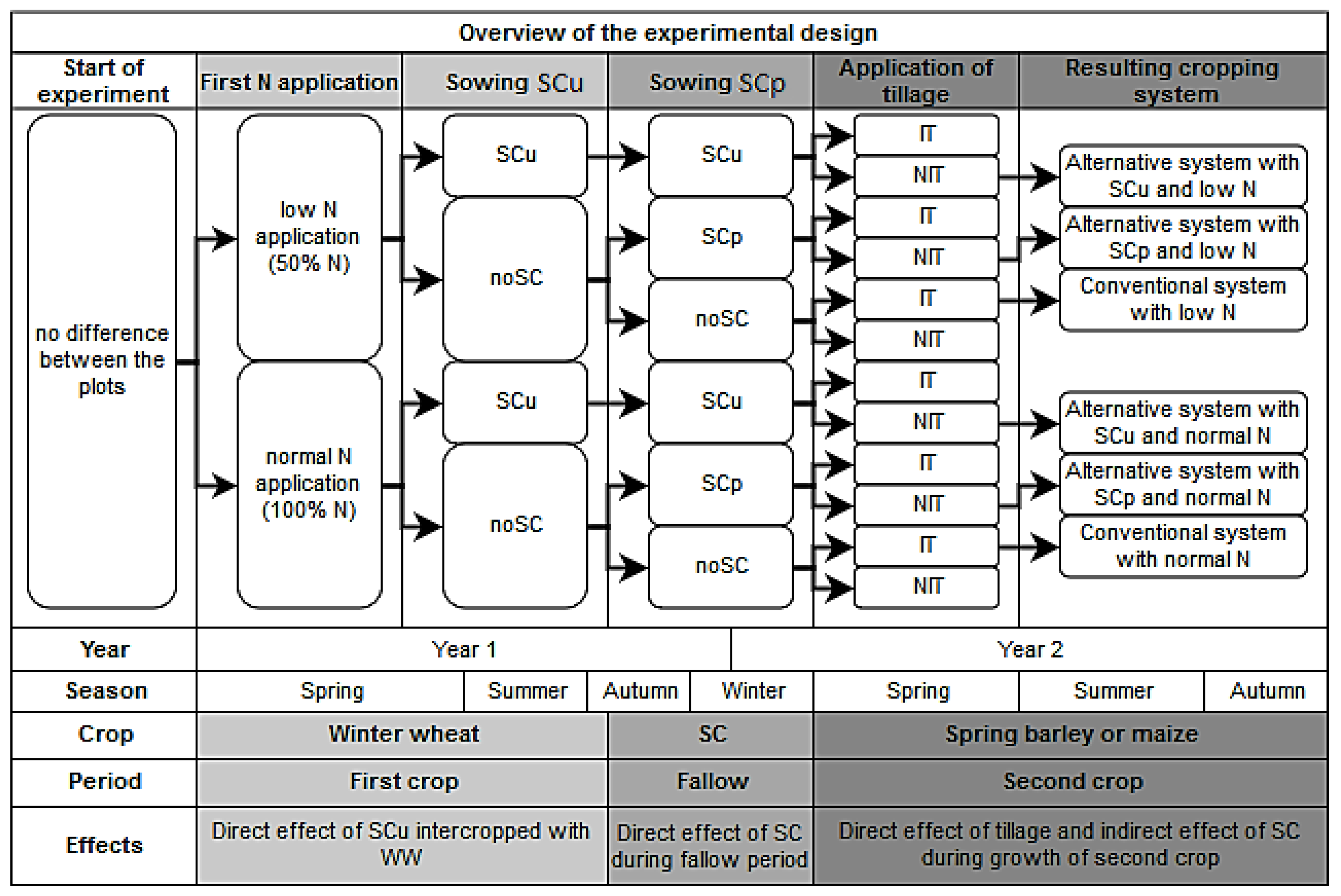
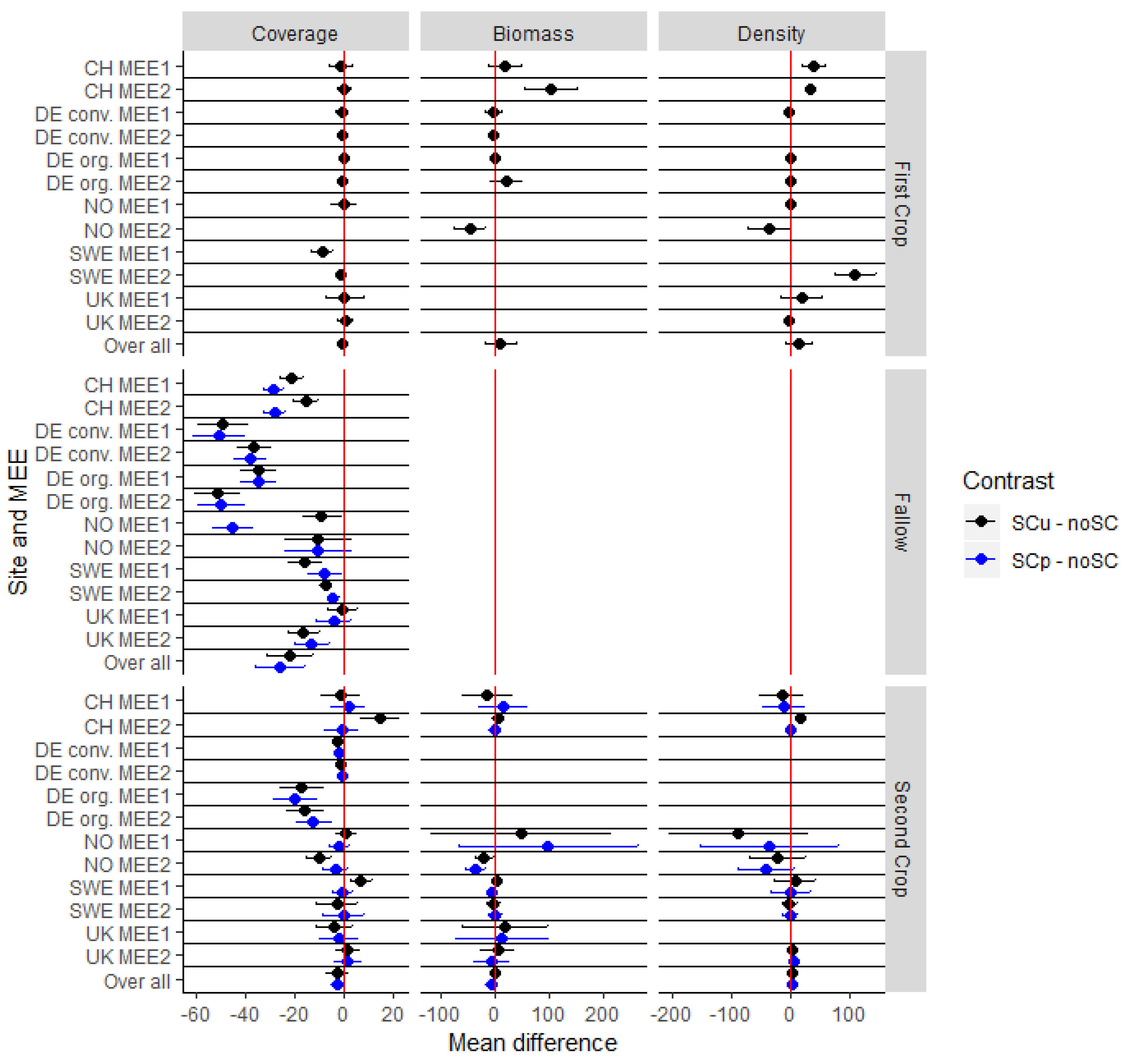
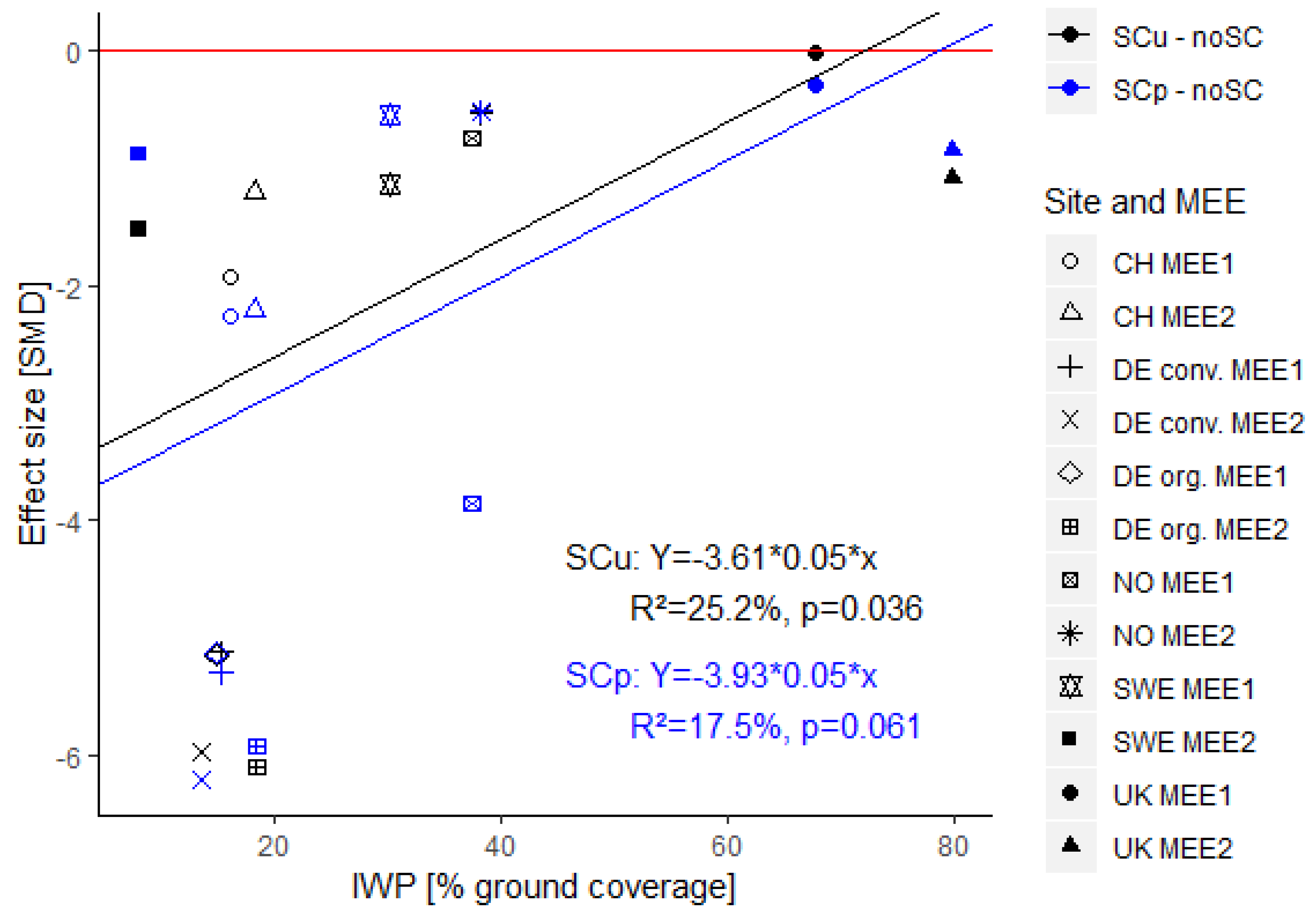
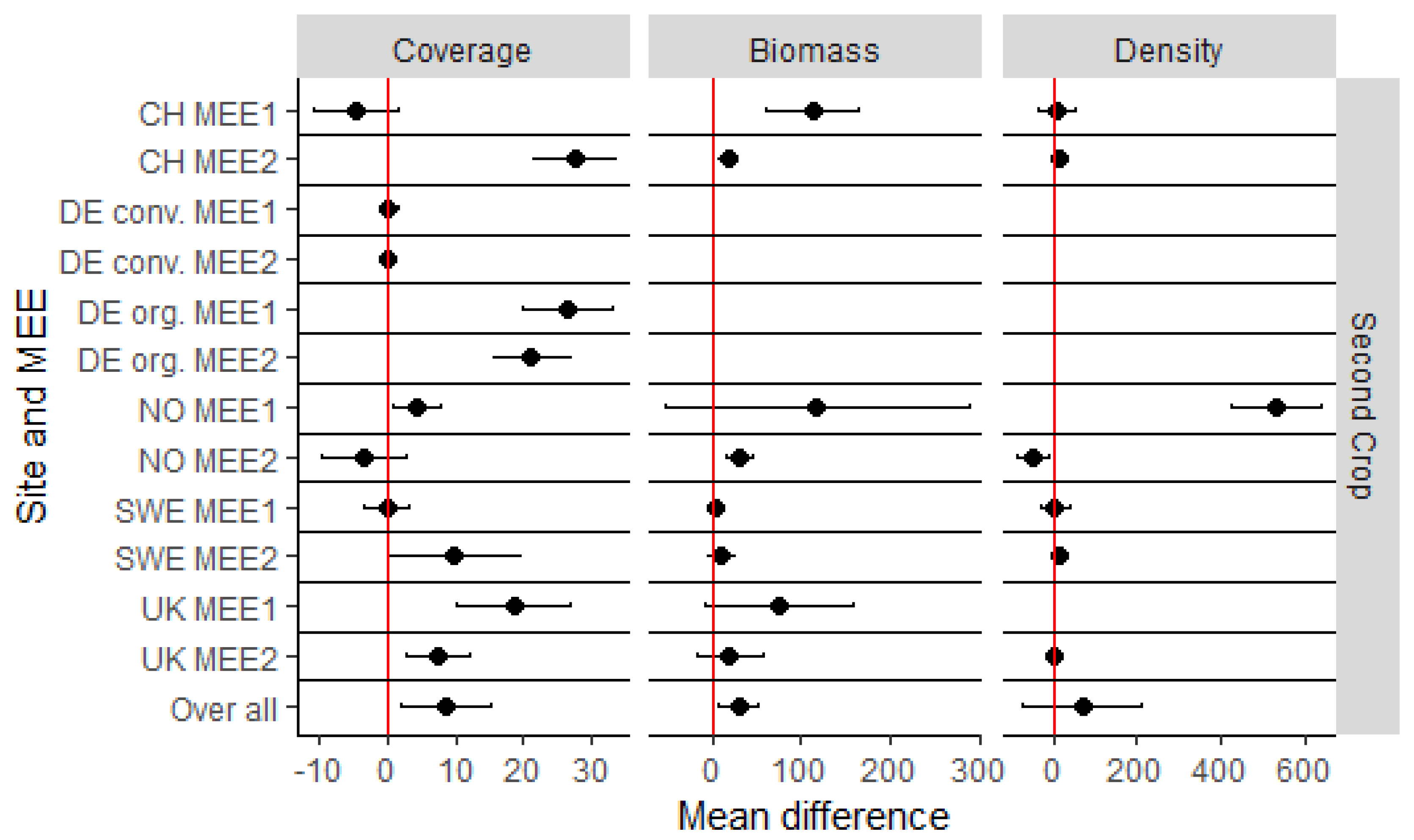
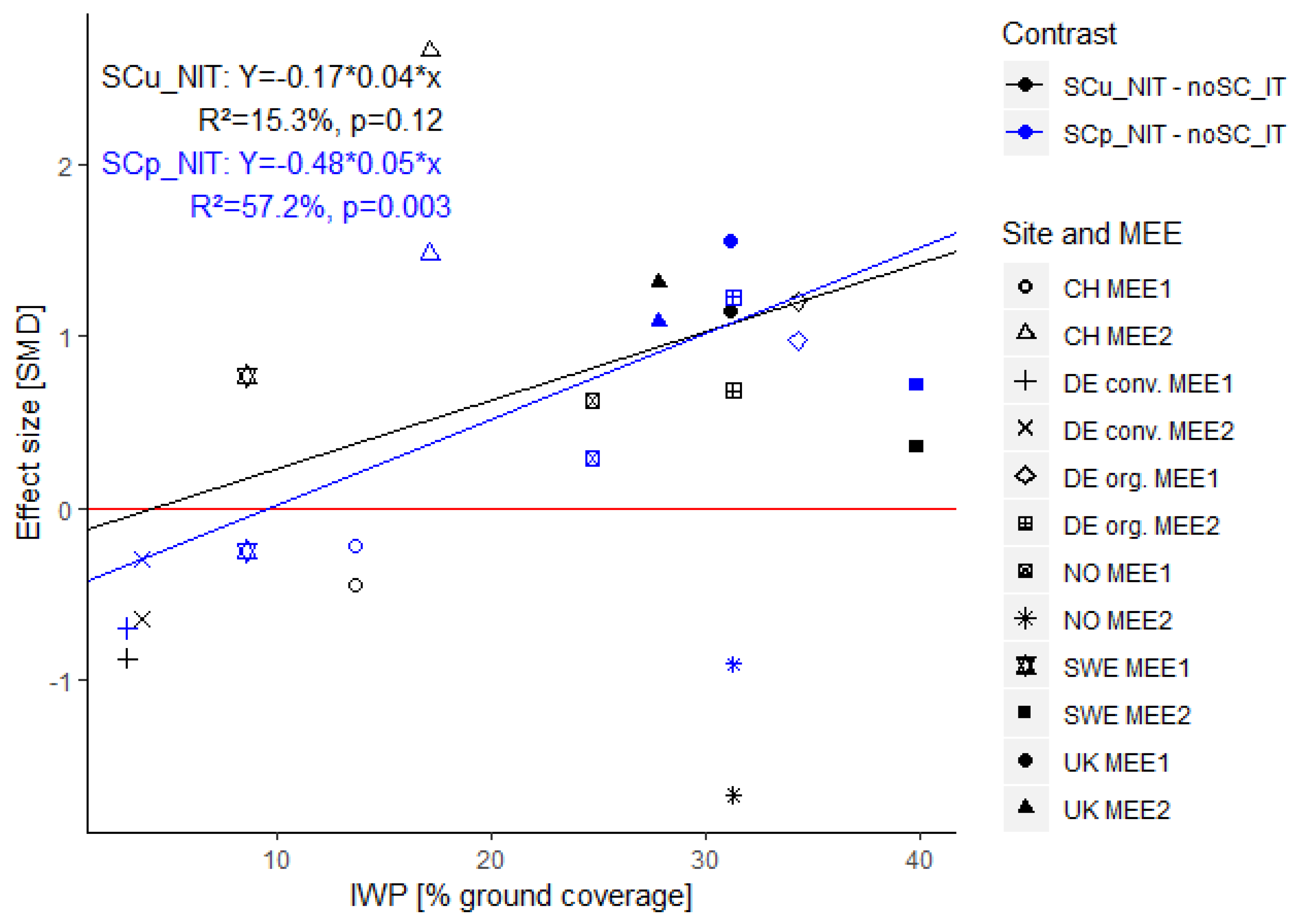
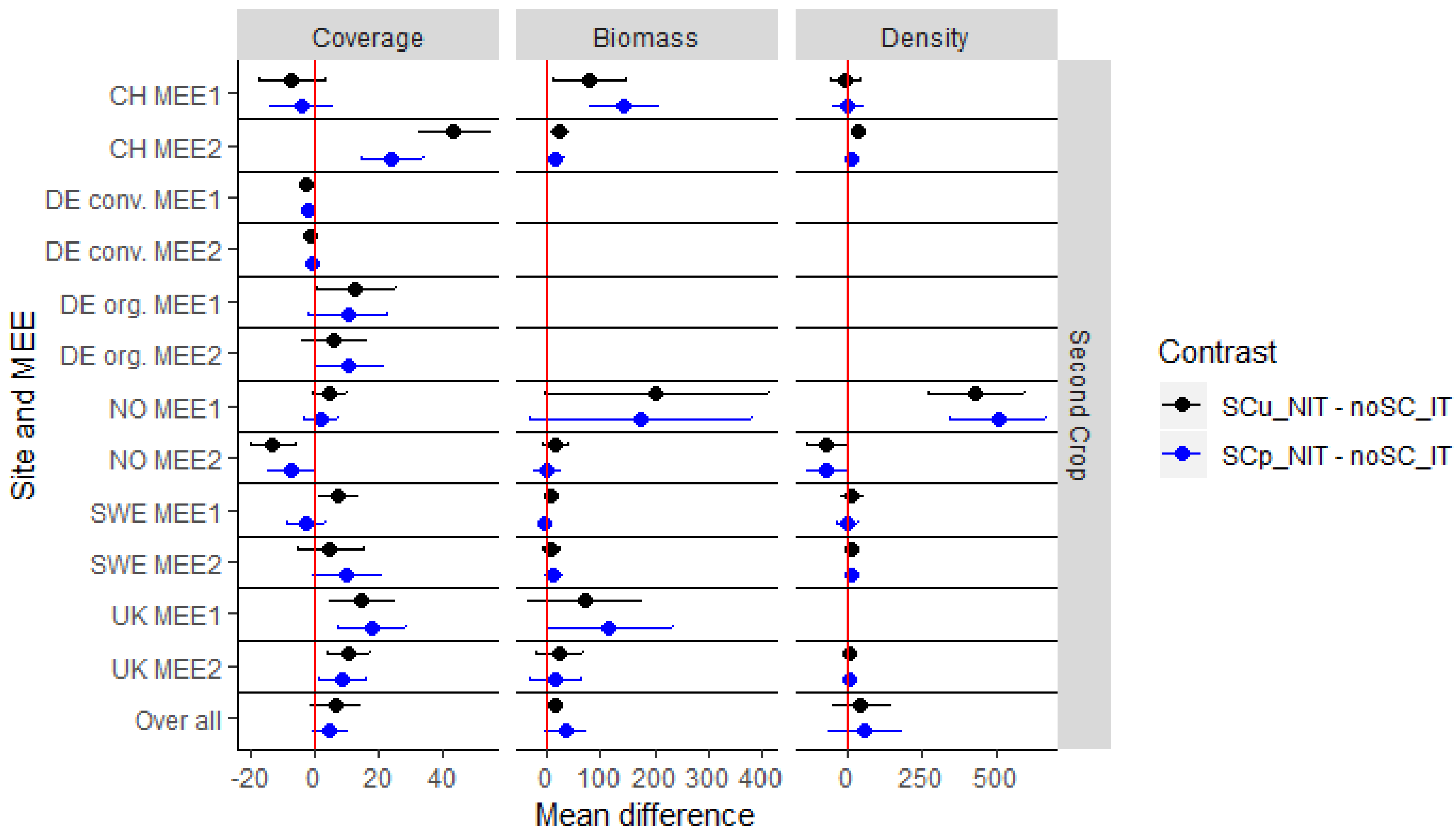
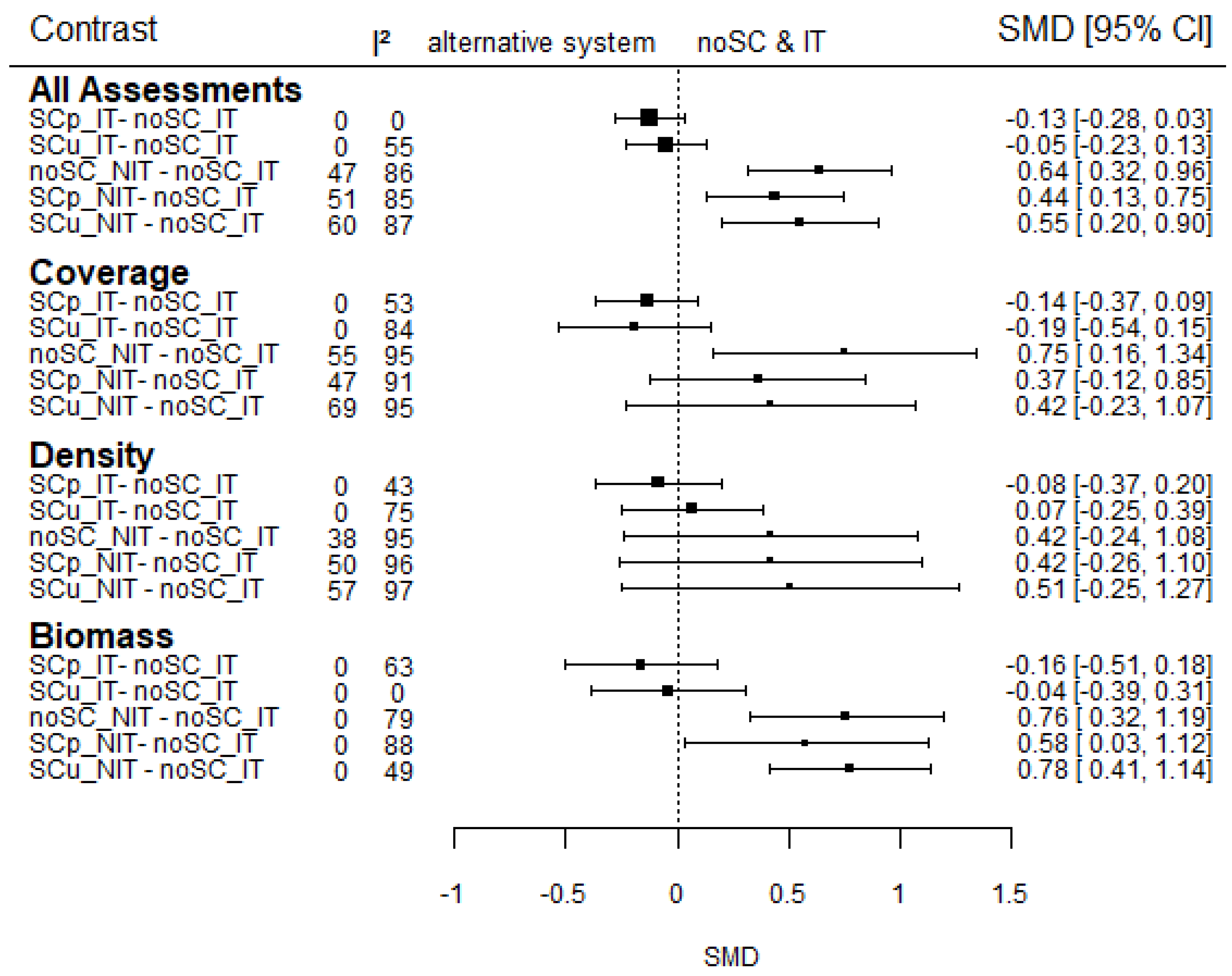
| Site | Additional weed control | Additional information |
|---|---|---|
| CH Tänikon, Switzerland conventional Soil: Loam; Typic Hapludalf | WW: herbicides used in noSC and SCp treatments: 8.25 g ha−1 a.i. iodosulfuron, 8.25 g ha−1 a.i. mesosulfuron, 180 g ha−1 a.i. fluroxypyr, 259.36 g ha−1 a.i. 1-methyl-heptylester M: herbicides used in IT: 105 g ha−1 a.i. mesotrione, 495 g ha−1 a.i. terbuthylazine, 1200 g ha−1 a.i. S-metolachlor, 40 g ha−1 a.i. nicosulfuron; In NIT: Hoeing | SCu sown again after harvest of WW due to expected poor re-seeding rate. |
| DE org. Freising, Germany Organic Soil: Clay; Eutric Haplocryalf | WW: harrowing once in April in both MEEs M: no additional weed control. | Wide row sowing (40 cm) of WW. Early establishment (end of July) of SCp. |
| DE conv. Freising, Germany conventional Soil: Clay; Eutric Haplocryalfs | WW: MEE1: 8.88 g ha−1 a.i. pyroxsulam, 2.96 g ha−1 a.i. flurasulam; MEE2: 13.66 g ha−1 a.i. pyroxsulam, 4.56 g ha−1 a.i. flurasulam. M: MEE1: 113.75 g ha−1 a.i. S-metolachlor, 656.25 g ha−1 a.i. terbuthylazine, 50 g ha−1 a.i. mesotrione; MEE2: 48 g ha−1 a.i. topramezone, 807 g ha−1 a.i. dimethenamid-P, 375 g ha−1 a.i. trbuthylazin and 150 g ha−1 a.i. bromoxynil | Wide row sowing (40 cm) of WW. Early establishment (end of July) of SCp. |
| NO Ås, Norway Organic Soil: Silty clay loam; Epistagnic Albeluvisol | WW: harrowing once in MEE1 (June) SB: harrowing once in MEE1 (July) and MEE2 (June), plus NIT MEE2 was hoed thrice (May and twice in June), All plants and plant residues in spring year two were mowed before tillage. | Due to weather conditions, cultivation and sowing very late in MEE1 and resulted in crop failure of SB in MEE1. Wide row spacing (25 cm) used in NIT plots of SB. |
| SWE Uppsala, Sweden Conventional Soil: Silty loam; Eutric Cambisol | WW: MEE2: 1 kg ha−1 a.i. bentazone M: 45g ha−1 a.i. mesotrione, 7.5 g ha−1 a.i. foram-sulfuron +0.025 g ha−1 a.i. iodosulfuron-methyl-sodium +7.5 g ha−1 a.i. isoxadifen-ethyl (safener) and 0.67 L ha−1 maize oil twice per year; In NIT: 1.2 kg ha−1 a.i. glyphosate use to kill subsidiary crops before tillage | No herbicide treatment was done in MEE1, to avoid damaging a sparse stand of white clover, which resulted in a total weed infestation by Matricaria chamomilla. IT was done late in autumn. NIT was done with a sowing machine with single disc coulters (Väderstad AB, Sweden). |
| UK Suffolk, Great Britain Organic Soil: Clay; Chromic Vertisol | WW: MEE2: inter-row harrowing in February and March with additional intra-row harrowing and filler strip weeded twice in April. SB: only IT: harrowing in MEE1 around 20 days after sowing | Pre-crops were long-time grass-clover leys. |
| Subsidiary Crops Under-Sown (SCu) | Subsidiary Crops Sown Post-hHarvest (SCp) | ||
|---|---|---|---|
| White clover (Trifolium repens) | NO, DE, SWE | Hairy vetch (Vicia villosa) | NO, DE, SWE, CH |
| Subterranean clover (Trifolium subterraneum) | DE, CH | Oilseed radish (Raphanus sativus) | DE, SWE, CH |
| Black medic (Medicago lupulina) | UK | ||
| Mixture of white clover (Trifolium repens) and perennial ryegrass (Lolium perenne) | SWE | Mixture of brassica species * | UK |
| Mixture of black medic (Medicago lupulina) and brassica species * | UK | ||
| Influencing Factor | Experimental Period | Assessment | Effect Size in SMD | Effect Size in Original Unit | I² in % | Moderators | |
|---|---|---|---|---|---|---|---|
| Subsidiary crops under-sown (SCu- noSC) | First crop | Overall | 0.14 | n.s. | 88% | Site n.s. | |
| Coverage | −0.19 | * | −0.46% | ||||
| Biomass | 0.16 | n.s. | 10.0 g m−2 | 71% | IWP *1, Site ***, Climate· | ||
| Density | 0.46 | n.s. | 14.7 m−2 | 93% | org./conv. *, Site n.s. | ||
| Fallow | Coverage | −2.19 | *** | −22.0% | 97% | IWP *, Site ***, Climate * | |
| Second crop | Overall | −0.12 | n.s. | 74% | Site ***, org./conv. · | ||
| Coverage | −0.36 | n.s. | −0.36% | 86% | Site * | ||
| Biomass | 0.01 | n.s. | 0.01 g m−2 | ||||
| Density | 0.07 | n.s. | 0.07 m−2 | 62% | IWP n.s. | ||
| Subsidiary crops sown post-harvest (SCp- noSC) | Fallow | Coverage | −2.52 | *** | −25.9% | 97% | Site ***, Climate *, IWP · |
| Second crop | Overall | −0.16 | * | 36% | Site *** | ||
| Coverage | −0.29 | * | −2.58% | 54% | Site *** | ||
| Biomass | −0.15 | n.s. | −5.86 g m−2 | ||||
| Density | −0.03 | n.s. | −2.74 m−2 | ||||
| Tillage (NIT-IT) | Second crop | Overall | 0.56 | *** | 89% | Site ** | |
| Coverage | 0.68 | *** | 8.69% | 93% | Site **, org./conv. n.s., IWP · | ||
| Biomass | 0.61 | *** | 27.8 g m−2 | ||||
| Density | 0.34 | n.s. | 69.7 m−2 | 93% | IWP * | ||
| Interaction (SCu_NIT–noSC_IT) | Second crop | Overall | 0.55 | ** | 76% | ||
| Coverage | 0.42 | n.s. | 6.62% | 85% | IWP n.s. | ||
| Biomass | 0.78 | *** | 14.6 g m−2 | ||||
| Density | 0.51 | n.s. | 43.2 m−2 | 82% | |||
| Interaction (SCp_NIT–noSC_IT) | Second crop | Overall | 0.44 | ** | 70% | Site n.s. | |
| Coverage | 0.37 | n.s. | 5.10% | 74% | Site n.s., IWP *1 | ||
| Biomass | 0.58 | * | 33.6 g m−2 | ||||
| Density | 0.42 | n.s. | 53.5 m−2 | 80% | IWP n.s. | ||
© 2019 by the authors. Licensee MDPI, Basel, Switzerland. This article is an open access article distributed under the terms and conditions of the Creative Commons Attribution (CC BY) license (http://creativecommons.org/licenses/by/4.0/).
Share and Cite
Reimer, M.; Ringselle, B.; Bergkvist, G.; Westaway, S.; Wittwer, R.; Baresel, J.P.; van der Heijden, M.G.A.; Mangerud, K.; Finckh, M.R.; Brandsæter, L.O. Interactive Effects of Subsidiary Crops and Weed Pressure in the Transition Period to Non-Inversion Tillage, A Case Study of Six Sites Across Northern and Central Europe. Agronomy 2019, 9, 495. https://doi.org/10.3390/agronomy9090495
Reimer M, Ringselle B, Bergkvist G, Westaway S, Wittwer R, Baresel JP, van der Heijden MGA, Mangerud K, Finckh MR, Brandsæter LO. Interactive Effects of Subsidiary Crops and Weed Pressure in the Transition Period to Non-Inversion Tillage, A Case Study of Six Sites Across Northern and Central Europe. Agronomy. 2019; 9(9):495. https://doi.org/10.3390/agronomy9090495
Chicago/Turabian StyleReimer, Marie, Björn Ringselle, Göran Bergkvist, Sally Westaway, Raphaël Wittwer, Jörg Peter Baresel, Marcel G. A. van der Heijden, Kjell Mangerud, Maria R. Finckh, and Lars Olav Brandsæter. 2019. "Interactive Effects of Subsidiary Crops and Weed Pressure in the Transition Period to Non-Inversion Tillage, A Case Study of Six Sites Across Northern and Central Europe" Agronomy 9, no. 9: 495. https://doi.org/10.3390/agronomy9090495
APA StyleReimer, M., Ringselle, B., Bergkvist, G., Westaway, S., Wittwer, R., Baresel, J. P., van der Heijden, M. G. A., Mangerud, K., Finckh, M. R., & Brandsæter, L. O. (2019). Interactive Effects of Subsidiary Crops and Weed Pressure in the Transition Period to Non-Inversion Tillage, A Case Study of Six Sites Across Northern and Central Europe. Agronomy, 9(9), 495. https://doi.org/10.3390/agronomy9090495






